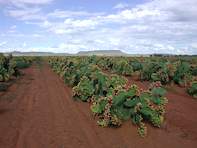Although cactus pear is found on many farms and home gardens throughout the country, it prefers the arid to semi arid conditions of the Eastern Cape, Karoo and Highveld.

It is difficult to quantify the area under production, as farmers are growing cactus pears for various reasons ranging from fodder to fresh fruit production and production aimed at the processing market.
The Cactus Pear Growers Association estimated that it had roughly 300 ha under fruit production in 2010, with some volumes even being exported. The area under production however halved to roughly 150 ha by 2017. There are various reasons for this.
Firstly, harvesting is difficult and labour intensive, with about five seasonal employees needed to harvest one hectare of plants. The fruit also ripen unevenly and have to be optimally ripe when picked, therefore it needs to be harvested several times a week until all the fruit has been picked. A permanent labourer is also required to manage orchards full-time throughout the year.
Secondly, the market is fickle. Farmers may achieve good prices in October, but prices become so low by January and February, when most of the fruit hit the market, that prices often do not justify production, picking and cleaning costs. The fruit also then has to compete with other deciduous fruit and for most growers, cactus pear production is a side-line.
The number of farmers planting cactus pear as animal fodder to carry them through times of drought have, nevertheless, greatly increased, according to Dr Herman Fouche from the Animal Production Institute of the Agricultural Research Centre. In the absence of coordinated record-keeping, he estimates this area can be anything between 1000 ha to 2 000 ha or more.
A few farmers have also started planting the species to produce oil from the cactus seed, which is in high demand internationally, in the cosmetic and pharmaceutical industries. While the processing facilities are available, the market for the oil is still quite undeveloped in South Africa, leading to poor local demand.
Farmers cannot make money from the red dye produced by the local species of cochineal used for biological control in South Africa, as they are significantly smaller and difficult to manage than the ones used for dye production internationally.
Production History in South Africa
South Africa imported its first cactus pear from the Americas in the mid-1700s, with the idea of using it as a “living fence” in the Western Cape. According to a publication of the ARC and University of the Free State, Verbouing van Doringlose Turksvye vir Voer- en Vrugteverbouing in die Hoëveld, a farmer from Graaff-Reinet, during this time, started producing cactus pear on his farm, Buffelshoek, from two leaves he brought in from Cape Town. Records also exist of a farmer, who cultivated and produced alcohol from the plants in the Camdeboo region.
During the 1850s the Pedi ruler, Sekwati planted the succulents to form a fence around Thaba Mosego and it was also used as fences for livestock around Sekukhuneland during the 1870s.
Without any natural enemies the species multiplied unhindered, with farmers by the 1860s starting to complain about the negative it was having on natural veld and sheep production. By 1874, it was labelled as one of the biggest pests from the Sourveld to the Snow Mountains. By the 1930s, it invested over a million hectares of land, primarily in the Eastern Cape and Karoo.
To address the problem, South Africa in 1913 imported Chocheneal and in 1924 imported Cactoblastis for biological control. While these insects helped to get the area under prickly pears under control, they unfortunately also started attacking cultivated crops.
Cactus Pear Season
South African cactus pears are primarily harvested from early December until the end of April, although in some areas fruit may be produced in winter, depending on the cultivar.